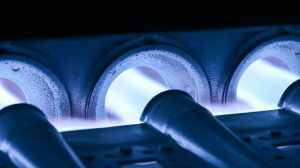Before we go farther in this post, we want you to know that natural gas furnaces are generally safe appliances to have in your homes. Millions of homes across the country use gas furnaces as their main source of heat, and they would not be permitted in so many households if they were major risks.
However, it’s important to know that gas furnaces can create combustion hazards or toxic gas leaks if they aren’t properly cared for with regular maintenance and don’t receive prompt heating repair in Pensacola, FL when necessary. In this post, we’re going to look at a specific furnace issue that can become hazardous: the cracked heat exchanger.
What the heat exchanger does
The heat exchanger is a critical component of your gas furnace. Its primary role is to separate combustion gases from the air that circulates throughout your home. When your furnace ignites natural gas, the flames heat the metal walls of the heat exchanger. Once these walls are hot, the furnace’s blower fan pushes air over them, warming the air before sending it into your ductwork and throughout your home.
The combustion gases created in this process remain inside the heat exchanger. From there, they are safely vented out of your house through the flue. This process ensures the air circulating in your home is free from harmful gases like carbon monoxide.
Why a cracked heat exchanger is hazardous
Over time, the metal in the heat exchanger can become weakened from repeated heating and cooling cycles, leading to cracks or splits. Even a small crack can pose a serious risk to your household because it creates a pathway for combustion gases, including carbon monoxide, to leak into your home’s airflow.
Carbon monoxide (CO) is a colorless, odorless, and highly dangerous gas. Even low levels of exposure can cause symptoms like headaches, dizziness, and nausea, while prolonged exposure can lead to serious health risks, including loss of consciousness or death. Because CO is so difficult to detect without the right equipment, any issue with your heat exchanger should be addressed immediately.
How to detect a cracked heat exchanger
Although you can’t directly see cracks in the heat exchanger without specialized equipment, there are a few warning signs that may point to this problem:
- Strange odors: If you notice a metallic or formaldehyde-like smell near the furnace, it could indicate a crack that is leaking combustion gases.
- Soot buildup: Black soot around the furnace or inside the furnace compartment may suggest incomplete combustion due to a damaged heat exchanger.
- Yellow burner flame: The burner flame in your furnace should be blue. A yellow or flickering flame is a sign that something is wrong with the combustion process, possibly because of a cracked heat exchanger.
- Unexplained illness: If people in your home experience frequent headaches, dizziness, or nausea, it could be a sign of carbon monoxide exposure.
- Frequent system shut-offs: If the furnace’s safety systems are turning the unit off repeatedly, it could be because the furnace detects a dangerous condition, such as a cracked heat exchanger.
Don’t take risks with your family’s safety. If you suspect your gas furnace has a cracked heat exchanger—or if your furnace is overdue for routine maintenance—contact us today. Our Peaden Pros will carefully inspect your heating system and recommend the best course of action to keep your home safe and comfortable.

